Epidemiological Impact of Air Pollution on Population Health: A Review
VerifiedAdded on 2022/08/27
|10
|2199
|11
Report
AI Summary
This report provides a comprehensive overview of the epidemiological impact of air pollution on public health, with a specific focus on the Australian context. The study investigates the relationship between air quality, particularly particulate matter (PM2.5), and respiratory health issues like asthma. The report analyzes studies from 2010 to 2020, employing peer-reviewed journals to assess the effects of air pollution on the population. Key findings highlight the adverse health effects associated with high concentrations of PM2.5, including increased asthma cases and reduced lung function. The report also explores the biological plausibility of these effects, examining how air pollutants trigger oxidative stress and immune responses. It discusses the impact of wildfires and ship exhaust on air quality and health, while also identifying gaps in current research and suggesting future directions, such as further investigation into the biological mechanisms of PM2.5 and the development of more effective air quality standards. The report emphasizes the need for government advisories and precautions to mitigate the harmful effects of air pollution.
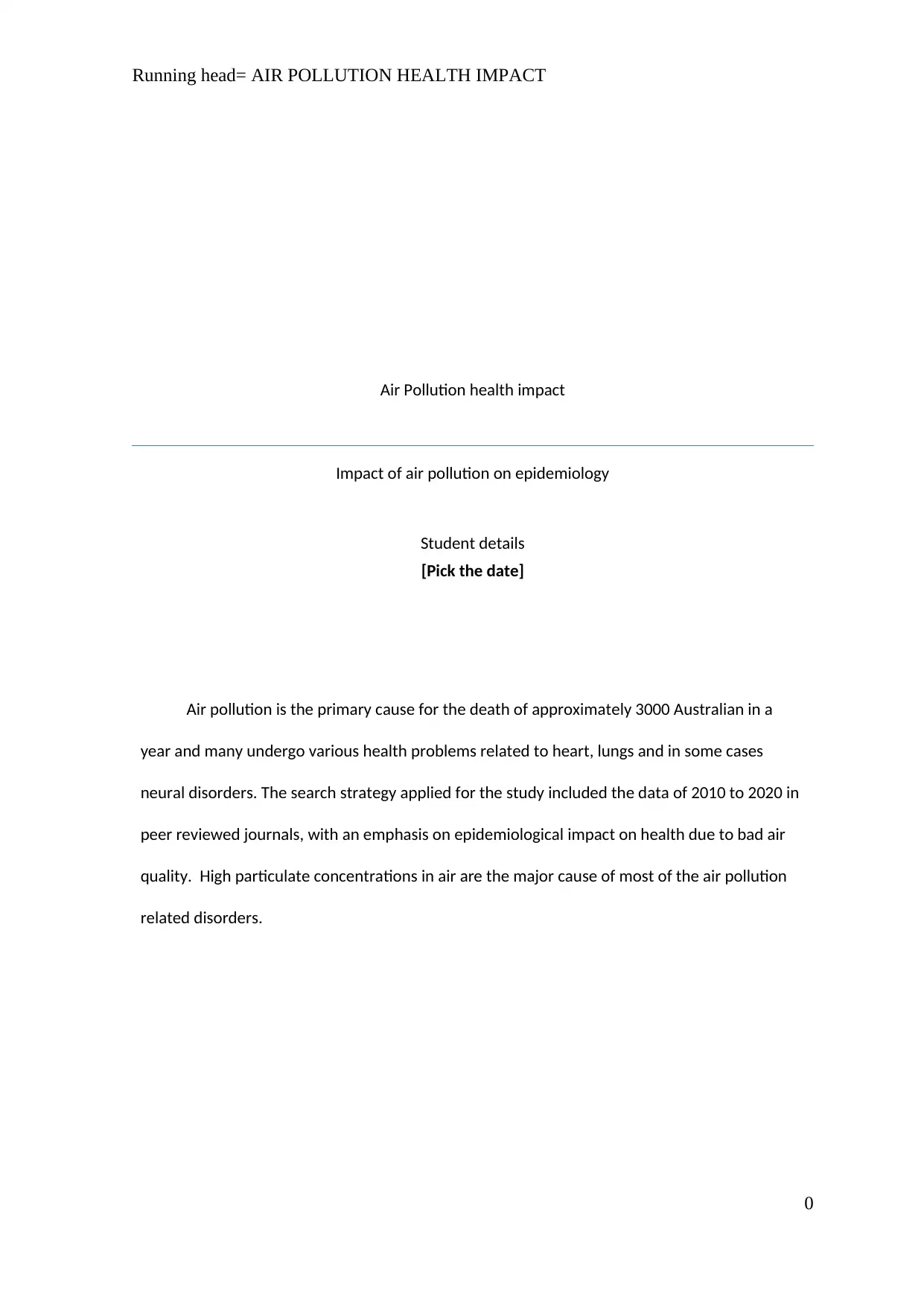
Running head= AIR POLLUTION HEALTH IMPACT
Air Pollution health impact
Impact of air pollution on epidemiology
Student details
[Pick the date]
Air pollution is the primary cause for the death of approximately 3000 Australian in a
year and many undergo various health problems related to heart, lungs and in some cases
neural disorders. The search strategy applied for the study included the data of 2010 to 2020 in
peer reviewed journals, with an emphasis on epidemiological impact on health due to bad air
quality. High particulate concentrations in air are the major cause of most of the air pollution
related disorders.
0
Air Pollution health impact
Impact of air pollution on epidemiology
Student details
[Pick the date]
Air pollution is the primary cause for the death of approximately 3000 Australian in a
year and many undergo various health problems related to heart, lungs and in some cases
neural disorders. The search strategy applied for the study included the data of 2010 to 2020 in
peer reviewed journals, with an emphasis on epidemiological impact on health due to bad air
quality. High particulate concentrations in air are the major cause of most of the air pollution
related disorders.
0
Paraphrase This Document
Need a fresh take? Get an instant paraphrase of this document with our AI Paraphraser
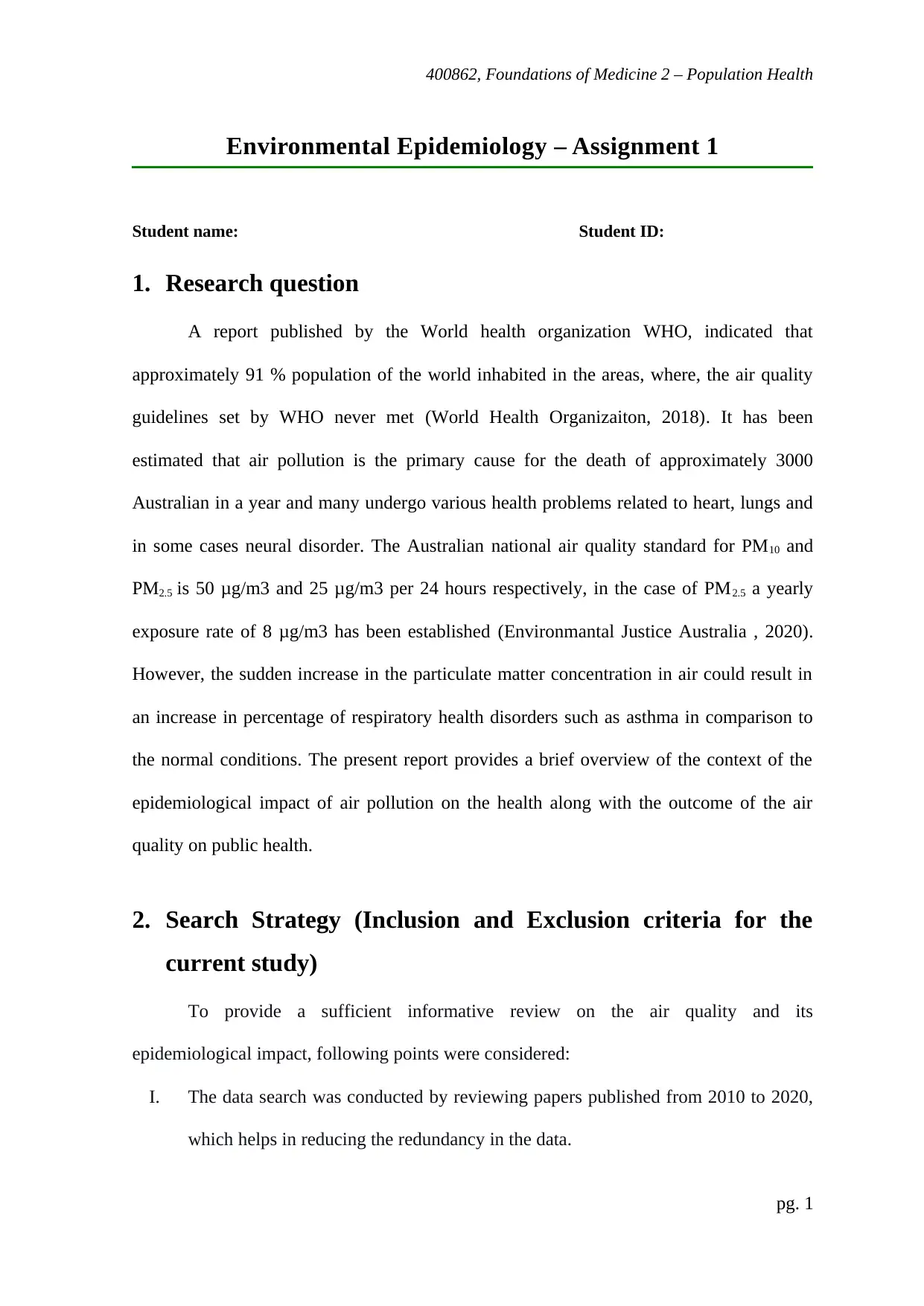
400862, Foundations of Medicine 2 – Population Health
Environmental Epidemiology – Assignment 1
Student name: Student ID:
1. Research question
A report published by the World health organization WHO, indicated that
approximately 91 % population of the world inhabited in the areas, where, the air quality
guidelines set by WHO never met (World Health Organizaiton, 2018). It has been
estimated that air pollution is the primary cause for the death of approximately 3000
Australian in a year and many undergo various health problems related to heart, lungs and
in some cases neural disorder. The Australian national air quality standard for PM10 and
PM2.5 is 50 μg/m3 and 25 μg/m3 per 24 hours respectively, in the case of PM2.5 a yearly
exposure rate of 8 μg/m3 has been established (Environmantal Justice Australia , 2020).
However, the sudden increase in the particulate matter concentration in air could result in
an increase in percentage of respiratory health disorders such as asthma in comparison to
the normal conditions. The present report provides a brief overview of the context of the
epidemiological impact of air pollution on the health along with the outcome of the air
quality on public health.
2. Search Strategy (Inclusion and Exclusion criteria for the
current study)
To provide a sufficient informative review on the air quality and its
epidemiological impact, following points were considered:
I. The data search was conducted by reviewing papers published from 2010 to 2020,
which helps in reducing the redundancy in the data.
pg. 1
Environmental Epidemiology – Assignment 1
Student name: Student ID:
1. Research question
A report published by the World health organization WHO, indicated that
approximately 91 % population of the world inhabited in the areas, where, the air quality
guidelines set by WHO never met (World Health Organizaiton, 2018). It has been
estimated that air pollution is the primary cause for the death of approximately 3000
Australian in a year and many undergo various health problems related to heart, lungs and
in some cases neural disorder. The Australian national air quality standard for PM10 and
PM2.5 is 50 μg/m3 and 25 μg/m3 per 24 hours respectively, in the case of PM2.5 a yearly
exposure rate of 8 μg/m3 has been established (Environmantal Justice Australia , 2020).
However, the sudden increase in the particulate matter concentration in air could result in
an increase in percentage of respiratory health disorders such as asthma in comparison to
the normal conditions. The present report provides a brief overview of the context of the
epidemiological impact of air pollution on the health along with the outcome of the air
quality on public health.
2. Search Strategy (Inclusion and Exclusion criteria for the
current study)
To provide a sufficient informative review on the air quality and its
epidemiological impact, following points were considered:
I. The data search was conducted by reviewing papers published from 2010 to 2020,
which helps in reducing the redundancy in the data.
pg. 1
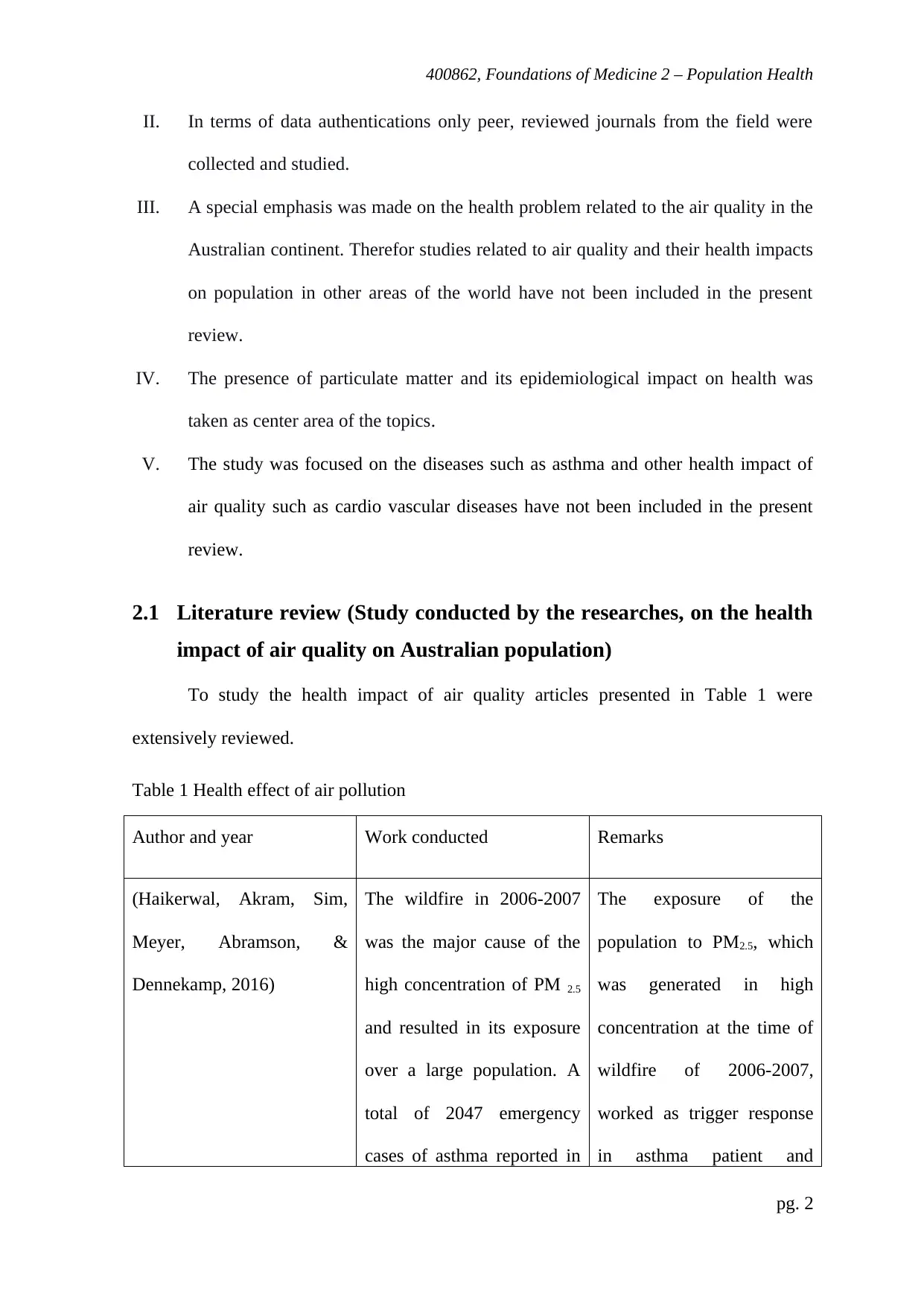
400862, Foundations of Medicine 2 – Population Health
II. In terms of data authentications only peer, reviewed journals from the field were
collected and studied.
III. A special emphasis was made on the health problem related to the air quality in the
Australian continent. Therefor studies related to air quality and their health impacts
on population in other areas of the world have not been included in the present
review.
IV. The presence of particulate matter and its epidemiological impact on health was
taken as center area of the topics.
V. The study was focused on the diseases such as asthma and other health impact of
air quality such as cardio vascular diseases have not been included in the present
review.
2.1 Literature review (Study conducted by the researches, on the health
impact of air quality on Australian population)
To study the health impact of air quality articles presented in Table 1 were
extensively reviewed.
Table 1 Health effect of air pollution
Author and year Work conducted Remarks
(Haikerwal, Akram, Sim,
Meyer, Abramson, &
Dennekamp, 2016)
The wildfire in 2006-2007
was the major cause of the
high concentration of PM 2.5
and resulted in its exposure
over a large population. A
total of 2047 emergency
cases of asthma reported in
The exposure of the
population to PM2.5, which
was generated in high
concentration at the time of
wildfire of 2006-2007,
worked as trigger response
in asthma patient and
pg. 2
II. In terms of data authentications only peer, reviewed journals from the field were
collected and studied.
III. A special emphasis was made on the health problem related to the air quality in the
Australian continent. Therefor studies related to air quality and their health impacts
on population in other areas of the world have not been included in the present
review.
IV. The presence of particulate matter and its epidemiological impact on health was
taken as center area of the topics.
V. The study was focused on the diseases such as asthma and other health impact of
air quality such as cardio vascular diseases have not been included in the present
review.
2.1 Literature review (Study conducted by the researches, on the health
impact of air quality on Australian population)
To study the health impact of air quality articles presented in Table 1 were
extensively reviewed.
Table 1 Health effect of air pollution
Author and year Work conducted Remarks
(Haikerwal, Akram, Sim,
Meyer, Abramson, &
Dennekamp, 2016)
The wildfire in 2006-2007
was the major cause of the
high concentration of PM 2.5
and resulted in its exposure
over a large population. A
total of 2047 emergency
cases of asthma reported in
The exposure of the
population to PM2.5, which
was generated in high
concentration at the time of
wildfire of 2006-2007,
worked as trigger response
in asthma patient and
pg. 2
⊘ This is a preview!⊘
Do you want full access?
Subscribe today to unlock all pages.

Trusted by 1+ million students worldwide
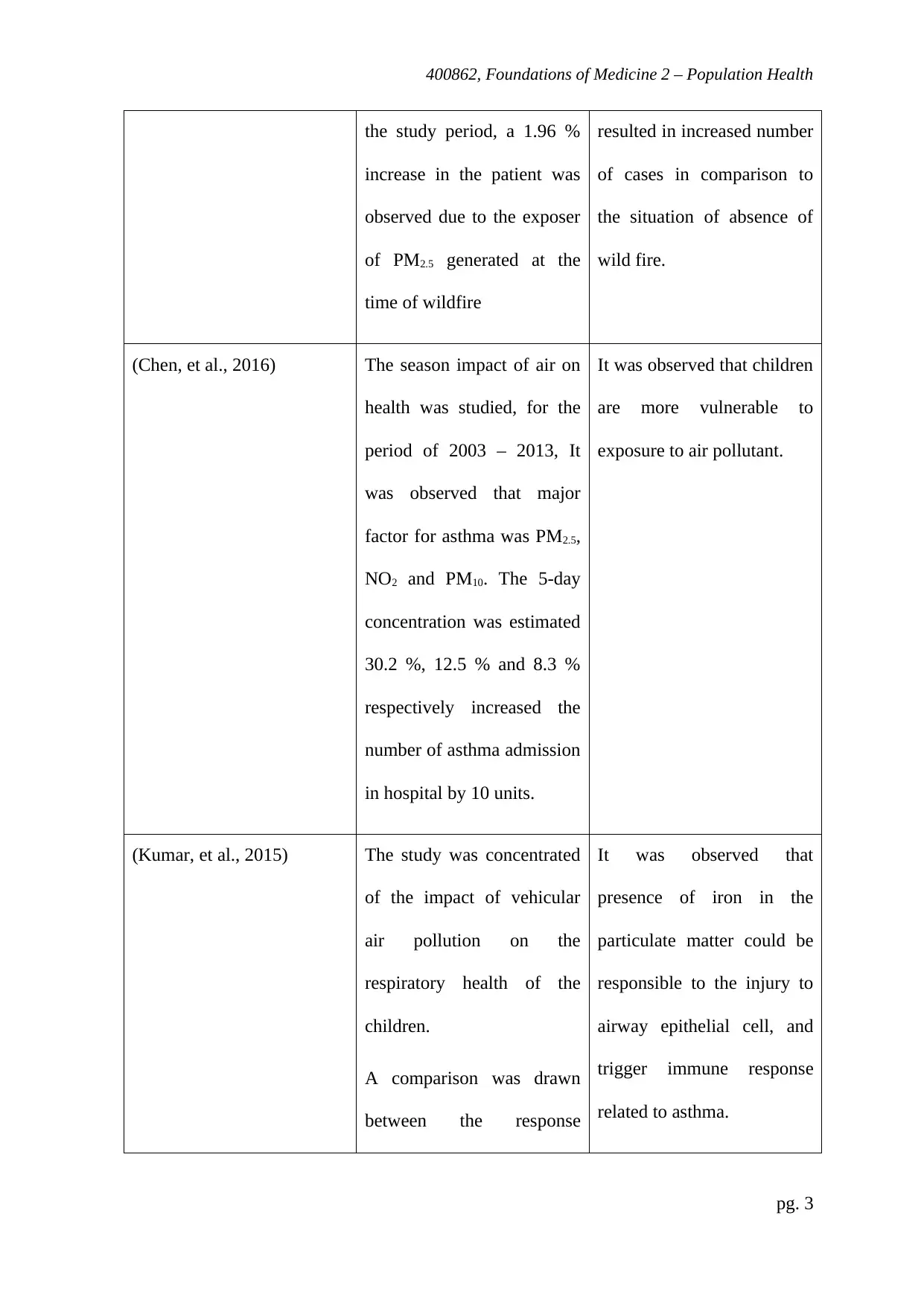
400862, Foundations of Medicine 2 – Population Health
the study period, a 1.96 %
increase in the patient was
observed due to the exposer
of PM2.5 generated at the
time of wildfire
resulted in increased number
of cases in comparison to
the situation of absence of
wild fire.
(Chen, et al., 2016) The season impact of air on
health was studied, for the
period of 2003 – 2013, It
was observed that major
factor for asthma was PM2.5,
NO2 and PM10. The 5-day
concentration was estimated
30.2 %, 12.5 % and 8.3 %
respectively increased the
number of asthma admission
in hospital by 10 units.
It was observed that children
are more vulnerable to
exposure to air pollutant.
(Kumar, et al., 2015) The study was concentrated
of the impact of vehicular
air pollution on the
respiratory health of the
children.
A comparison was drawn
between the response
It was observed that
presence of iron in the
particulate matter could be
responsible to the injury to
airway epithelial cell, and
trigger immune response
related to asthma.
pg. 3
the study period, a 1.96 %
increase in the patient was
observed due to the exposer
of PM2.5 generated at the
time of wildfire
resulted in increased number
of cases in comparison to
the situation of absence of
wild fire.
(Chen, et al., 2016) The season impact of air on
health was studied, for the
period of 2003 – 2013, It
was observed that major
factor for asthma was PM2.5,
NO2 and PM10. The 5-day
concentration was estimated
30.2 %, 12.5 % and 8.3 %
respectively increased the
number of asthma admission
in hospital by 10 units.
It was observed that children
are more vulnerable to
exposure to air pollutant.
(Kumar, et al., 2015) The study was concentrated
of the impact of vehicular
air pollution on the
respiratory health of the
children.
A comparison was drawn
between the response
It was observed that
presence of iron in the
particulate matter could be
responsible to the injury to
airway epithelial cell, and
trigger immune response
related to asthma.
pg. 3
Paraphrase This Document
Need a fresh take? Get an instant paraphrase of this document with our AI Paraphraser
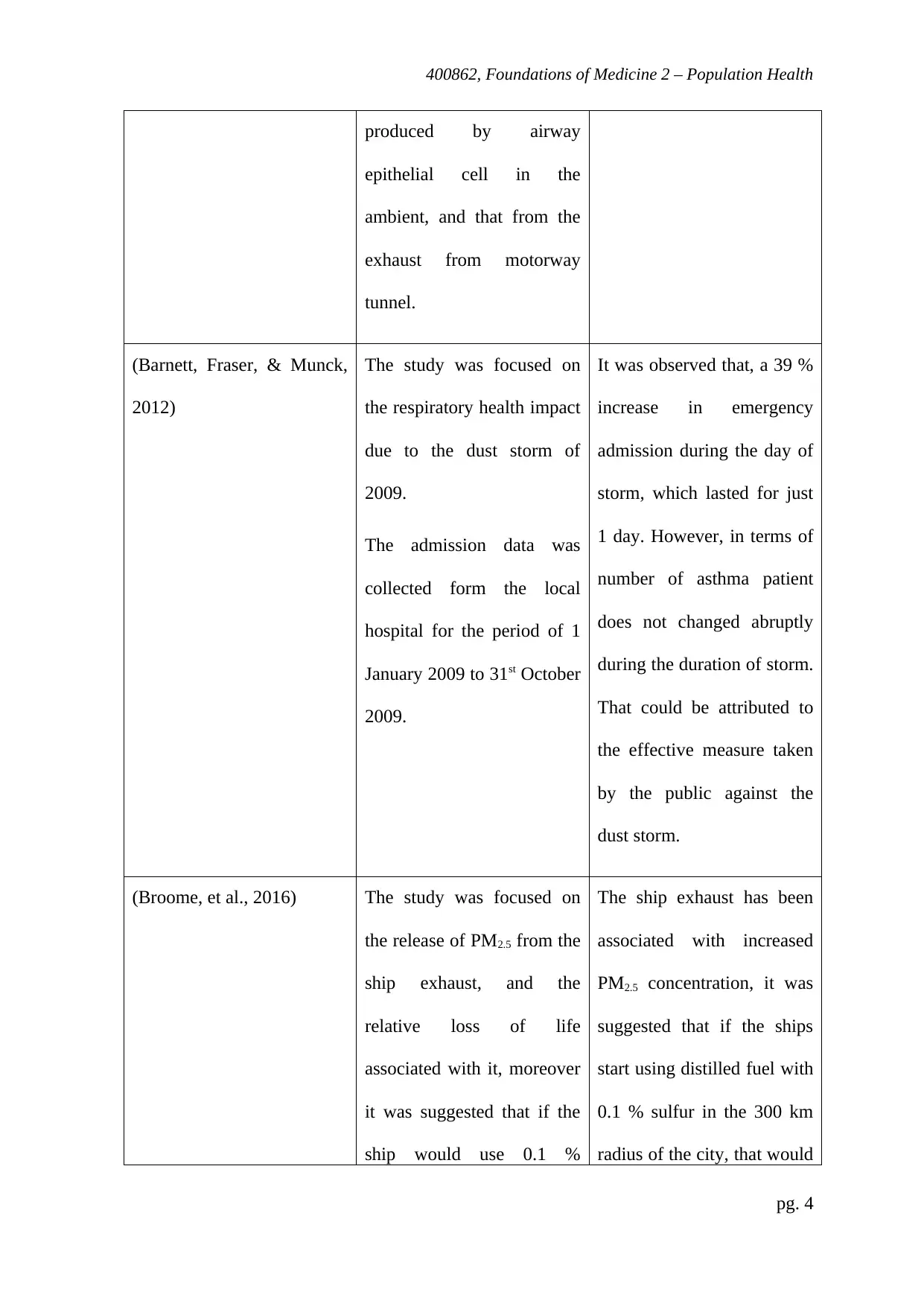
400862, Foundations of Medicine 2 – Population Health
produced by airway
epithelial cell in the
ambient, and that from the
exhaust from motorway
tunnel.
(Barnett, Fraser, & Munck,
2012)
The study was focused on
the respiratory health impact
due to the dust storm of
2009.
The admission data was
collected form the local
hospital for the period of 1
January 2009 to 31st October
2009.
It was observed that, a 39 %
increase in emergency
admission during the day of
storm, which lasted for just
1 day. However, in terms of
number of asthma patient
does not changed abruptly
during the duration of storm.
That could be attributed to
the effective measure taken
by the public against the
dust storm.
(Broome, et al., 2016) The study was focused on
the release of PM2.5 from the
ship exhaust, and the
relative loss of life
associated with it, moreover
it was suggested that if the
ship would use 0.1 %
The ship exhaust has been
associated with increased
PM2.5 concentration, it was
suggested that if the ships
start using distilled fuel with
0.1 % sulfur in the 300 km
radius of the city, that would
pg. 4
produced by airway
epithelial cell in the
ambient, and that from the
exhaust from motorway
tunnel.
(Barnett, Fraser, & Munck,
2012)
The study was focused on
the respiratory health impact
due to the dust storm of
2009.
The admission data was
collected form the local
hospital for the period of 1
January 2009 to 31st October
2009.
It was observed that, a 39 %
increase in emergency
admission during the day of
storm, which lasted for just
1 day. However, in terms of
number of asthma patient
does not changed abruptly
during the duration of storm.
That could be attributed to
the effective measure taken
by the public against the
dust storm.
(Broome, et al., 2016) The study was focused on
the release of PM2.5 from the
ship exhaust, and the
relative loss of life
associated with it, moreover
it was suggested that if the
ship would use 0.1 %
The ship exhaust has been
associated with increased
PM2.5 concentration, it was
suggested that if the ships
start using distilled fuel with
0.1 % sulfur in the 300 km
radius of the city, that would
pg. 4
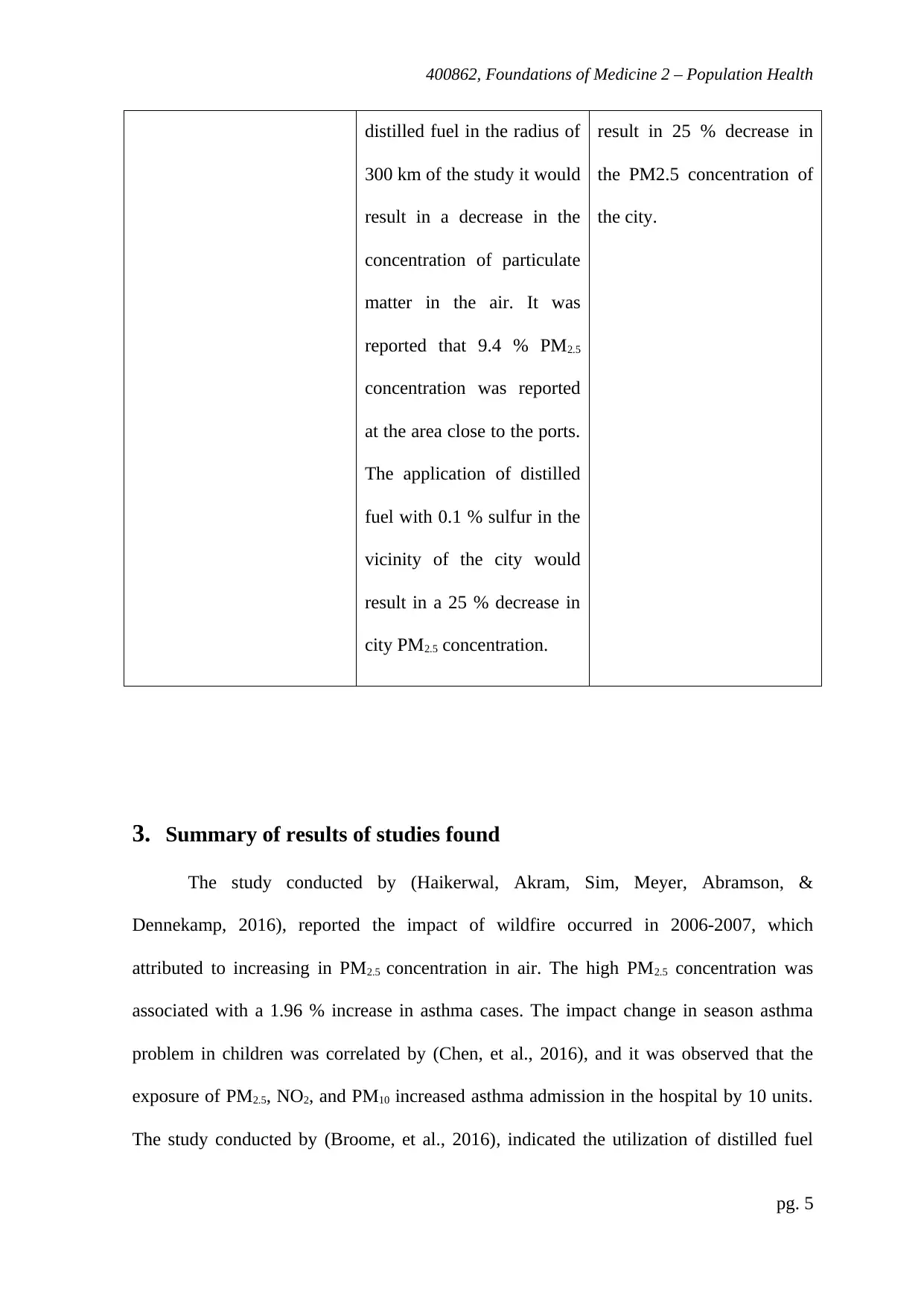
400862, Foundations of Medicine 2 – Population Health
distilled fuel in the radius of
300 km of the study it would
result in a decrease in the
concentration of particulate
matter in the air. It was
reported that 9.4 % PM2.5
concentration was reported
at the area close to the ports.
The application of distilled
fuel with 0.1 % sulfur in the
vicinity of the city would
result in a 25 % decrease in
city PM2.5 concentration.
result in 25 % decrease in
the PM2.5 concentration of
the city.
3. Summary of results of studies found
The study conducted by (Haikerwal, Akram, Sim, Meyer, Abramson, &
Dennekamp, 2016), reported the impact of wildfire occurred in 2006-2007, which
attributed to increasing in PM2.5 concentration in air. The high PM2.5 concentration was
associated with a 1.96 % increase in asthma cases. The impact change in season asthma
problem in children was correlated by (Chen, et al., 2016), and it was observed that the
exposure of PM2.5, NO2, and PM10 increased asthma admission in the hospital by 10 units.
The study conducted by (Broome, et al., 2016), indicated the utilization of distilled fuel
pg. 5
distilled fuel in the radius of
300 km of the study it would
result in a decrease in the
concentration of particulate
matter in the air. It was
reported that 9.4 % PM2.5
concentration was reported
at the area close to the ports.
The application of distilled
fuel with 0.1 % sulfur in the
vicinity of the city would
result in a 25 % decrease in
city PM2.5 concentration.
result in 25 % decrease in
the PM2.5 concentration of
the city.
3. Summary of results of studies found
The study conducted by (Haikerwal, Akram, Sim, Meyer, Abramson, &
Dennekamp, 2016), reported the impact of wildfire occurred in 2006-2007, which
attributed to increasing in PM2.5 concentration in air. The high PM2.5 concentration was
associated with a 1.96 % increase in asthma cases. The impact change in season asthma
problem in children was correlated by (Chen, et al., 2016), and it was observed that the
exposure of PM2.5, NO2, and PM10 increased asthma admission in the hospital by 10 units.
The study conducted by (Broome, et al., 2016), indicated the utilization of distilled fuel
pg. 5
⊘ This is a preview!⊘
Do you want full access?
Subscribe today to unlock all pages.

Trusted by 1+ million students worldwide
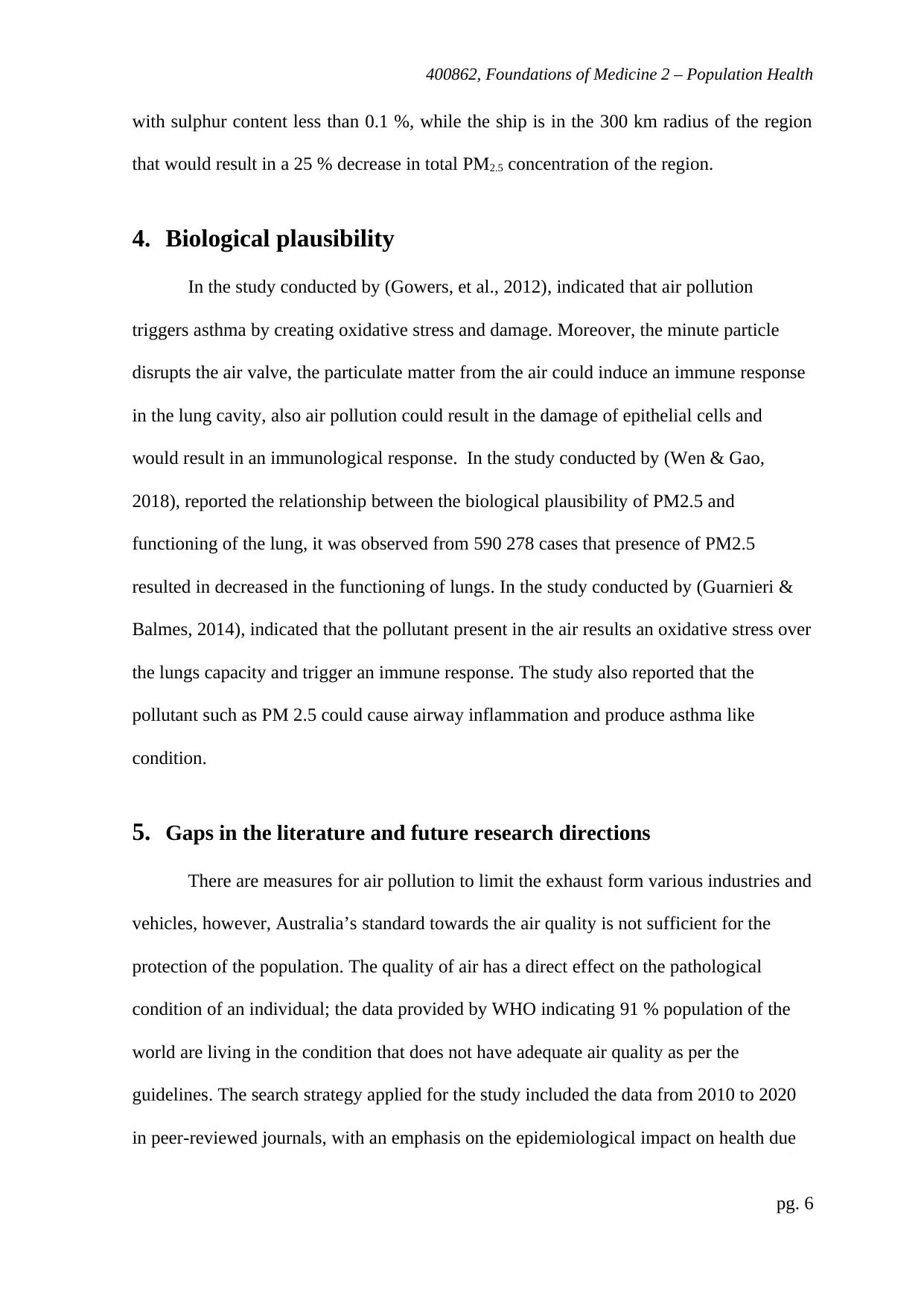
400862, Foundations of Medicine 2 – Population Health
with sulphur content less than 0.1 %, while the ship is in the 300 km radius of the region
that would result in a 25 % decrease in total PM2.5 concentration of the region.
4. Biological plausibility
In the study conducted by (Gowers, et al., 2012), indicated that air pollution
triggers asthma by creating oxidative stress and damage. Moreover, the minute particle
disrupts the air valve, the particulate matter from the air could induce an immune response
in the lung cavity, also air pollution could result in the damage of epithelial cells and
would result in an immunological response. In the study conducted by (Wen & Gao,
2018), reported the relationship between the biological plausibility of PM2.5 and
functioning of the lung, it was observed from 590 278 cases that presence of PM2.5
resulted in decreased in the functioning of lungs. In the study conducted by (Guarnieri &
Balmes, 2014), indicated that the pollutant present in the air results an oxidative stress over
the lungs capacity and trigger an immune response. The study also reported that the
pollutant such as PM 2.5 could cause airway inflammation and produce asthma like
condition.
5. Gaps in the literature and future research directions
There are measures for air pollution to limit the exhaust form various industries and
vehicles, however, Australia’s standard towards the air quality is not sufficient for the
protection of the population. The quality of air has a direct effect on the pathological
condition of an individual; the data provided by WHO indicating 91 % population of the
world are living in the condition that does not have adequate air quality as per the
guidelines. The search strategy applied for the study included the data from 2010 to 2020
in peer-reviewed journals, with an emphasis on the epidemiological impact on health due
pg. 6
with sulphur content less than 0.1 %, while the ship is in the 300 km radius of the region
that would result in a 25 % decrease in total PM2.5 concentration of the region.
4. Biological plausibility
In the study conducted by (Gowers, et al., 2012), indicated that air pollution
triggers asthma by creating oxidative stress and damage. Moreover, the minute particle
disrupts the air valve, the particulate matter from the air could induce an immune response
in the lung cavity, also air pollution could result in the damage of epithelial cells and
would result in an immunological response. In the study conducted by (Wen & Gao,
2018), reported the relationship between the biological plausibility of PM2.5 and
functioning of the lung, it was observed from 590 278 cases that presence of PM2.5
resulted in decreased in the functioning of lungs. In the study conducted by (Guarnieri &
Balmes, 2014), indicated that the pollutant present in the air results an oxidative stress over
the lungs capacity and trigger an immune response. The study also reported that the
pollutant such as PM 2.5 could cause airway inflammation and produce asthma like
condition.
5. Gaps in the literature and future research directions
There are measures for air pollution to limit the exhaust form various industries and
vehicles, however, Australia’s standard towards the air quality is not sufficient for the
protection of the population. The quality of air has a direct effect on the pathological
condition of an individual; the data provided by WHO indicating 91 % population of the
world are living in the condition that does not have adequate air quality as per the
guidelines. The search strategy applied for the study included the data from 2010 to 2020
in peer-reviewed journals, with an emphasis on the epidemiological impact on health due
pg. 6
Paraphrase This Document
Need a fresh take? Get an instant paraphrase of this document with our AI Paraphraser
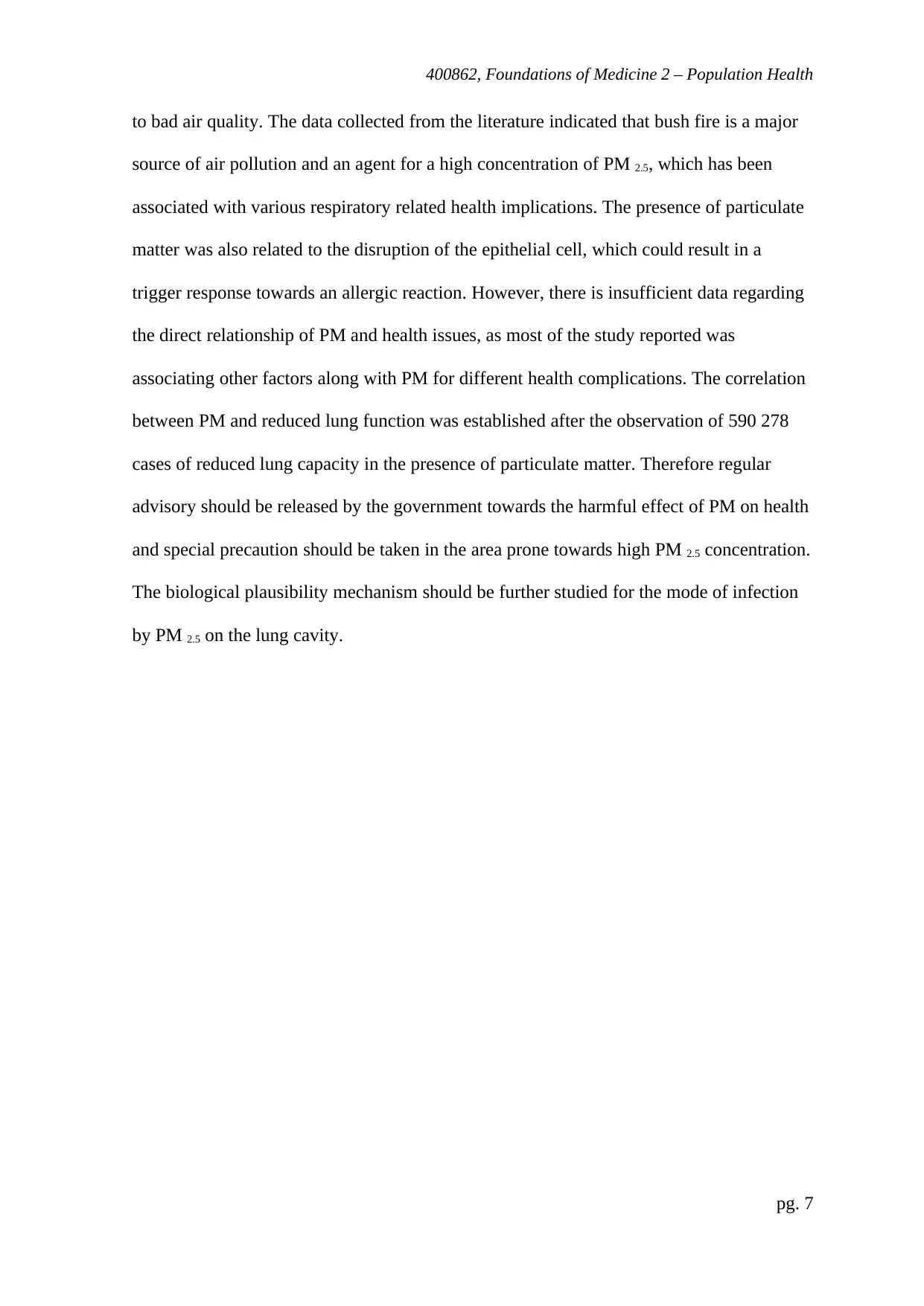
400862, Foundations of Medicine 2 – Population Health
to bad air quality. The data collected from the literature indicated that bush fire is a major
source of air pollution and an agent for a high concentration of PM 2.5, which has been
associated with various respiratory related health implications. The presence of particulate
matter was also related to the disruption of the epithelial cell, which could result in a
trigger response towards an allergic reaction. However, there is insufficient data regarding
the direct relationship of PM and health issues, as most of the study reported was
associating other factors along with PM for different health complications. The correlation
between PM and reduced lung function was established after the observation of 590 278
cases of reduced lung capacity in the presence of particulate matter. Therefore regular
advisory should be released by the government towards the harmful effect of PM on health
and special precaution should be taken in the area prone towards high PM 2.5 concentration.
The biological plausibility mechanism should be further studied for the mode of infection
by PM 2.5 on the lung cavity.
pg. 7
to bad air quality. The data collected from the literature indicated that bush fire is a major
source of air pollution and an agent for a high concentration of PM 2.5, which has been
associated with various respiratory related health implications. The presence of particulate
matter was also related to the disruption of the epithelial cell, which could result in a
trigger response towards an allergic reaction. However, there is insufficient data regarding
the direct relationship of PM and health issues, as most of the study reported was
associating other factors along with PM for different health complications. The correlation
between PM and reduced lung function was established after the observation of 590 278
cases of reduced lung capacity in the presence of particulate matter. Therefore regular
advisory should be released by the government towards the harmful effect of PM on health
and special precaution should be taken in the area prone towards high PM 2.5 concentration.
The biological plausibility mechanism should be further studied for the mode of infection
by PM 2.5 on the lung cavity.
pg. 7
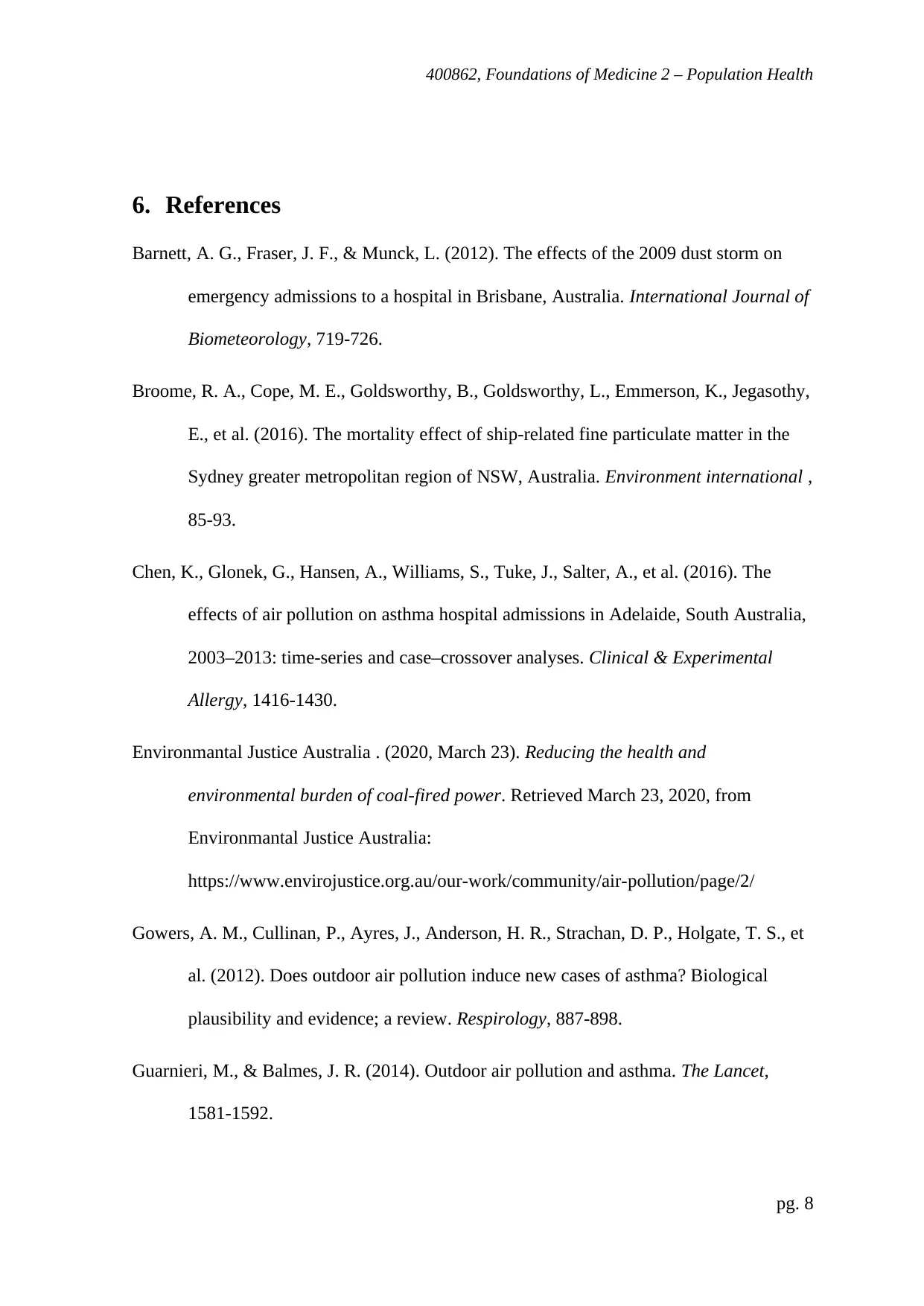
400862, Foundations of Medicine 2 – Population Health
6. References
Barnett, A. G., Fraser, J. F., & Munck, L. (2012). The effects of the 2009 dust storm on
emergency admissions to a hospital in Brisbane, Australia. International Journal of
Biometeorology, 719-726.
Broome, R. A., Cope, M. E., Goldsworthy, B., Goldsworthy, L., Emmerson, K., Jegasothy,
E., et al. (2016). The mortality effect of ship-related fine particulate matter in the
Sydney greater metropolitan region of NSW, Australia. Environment international ,
85-93.
Chen, K., Glonek, G., Hansen, A., Williams, S., Tuke, J., Salter, A., et al. (2016). The
effects of air pollution on asthma hospital admissions in Adelaide, South Australia,
2003–2013: time‐series and case–crossover analyses. Clinical & Experimental
Allergy, 1416-1430.
Environmantal Justice Australia . (2020, March 23). Reducing the health and
environmental burden of coal-fired power. Retrieved March 23, 2020, from
Environmantal Justice Australia:
https://www.envirojustice.org.au/our-work/community/air-pollution/page/2/
Gowers, A. M., Cullinan, P., Ayres, J., Anderson, H. R., Strachan, D. P., Holgate, T. S., et
al. (2012). Does outdoor air pollution induce new cases of asthma? Biological
plausibility and evidence; a review. Respirology, 887-898.
Guarnieri, M., & Balmes, J. R. (2014). Outdoor air pollution and asthma. The Lancet,
1581-1592.
pg. 8
6. References
Barnett, A. G., Fraser, J. F., & Munck, L. (2012). The effects of the 2009 dust storm on
emergency admissions to a hospital in Brisbane, Australia. International Journal of
Biometeorology, 719-726.
Broome, R. A., Cope, M. E., Goldsworthy, B., Goldsworthy, L., Emmerson, K., Jegasothy,
E., et al. (2016). The mortality effect of ship-related fine particulate matter in the
Sydney greater metropolitan region of NSW, Australia. Environment international ,
85-93.
Chen, K., Glonek, G., Hansen, A., Williams, S., Tuke, J., Salter, A., et al. (2016). The
effects of air pollution on asthma hospital admissions in Adelaide, South Australia,
2003–2013: time‐series and case–crossover analyses. Clinical & Experimental
Allergy, 1416-1430.
Environmantal Justice Australia . (2020, March 23). Reducing the health and
environmental burden of coal-fired power. Retrieved March 23, 2020, from
Environmantal Justice Australia:
https://www.envirojustice.org.au/our-work/community/air-pollution/page/2/
Gowers, A. M., Cullinan, P., Ayres, J., Anderson, H. R., Strachan, D. P., Holgate, T. S., et
al. (2012). Does outdoor air pollution induce new cases of asthma? Biological
plausibility and evidence; a review. Respirology, 887-898.
Guarnieri, M., & Balmes, J. R. (2014). Outdoor air pollution and asthma. The Lancet,
1581-1592.
pg. 8
⊘ This is a preview!⊘
Do you want full access?
Subscribe today to unlock all pages.

Trusted by 1+ million students worldwide
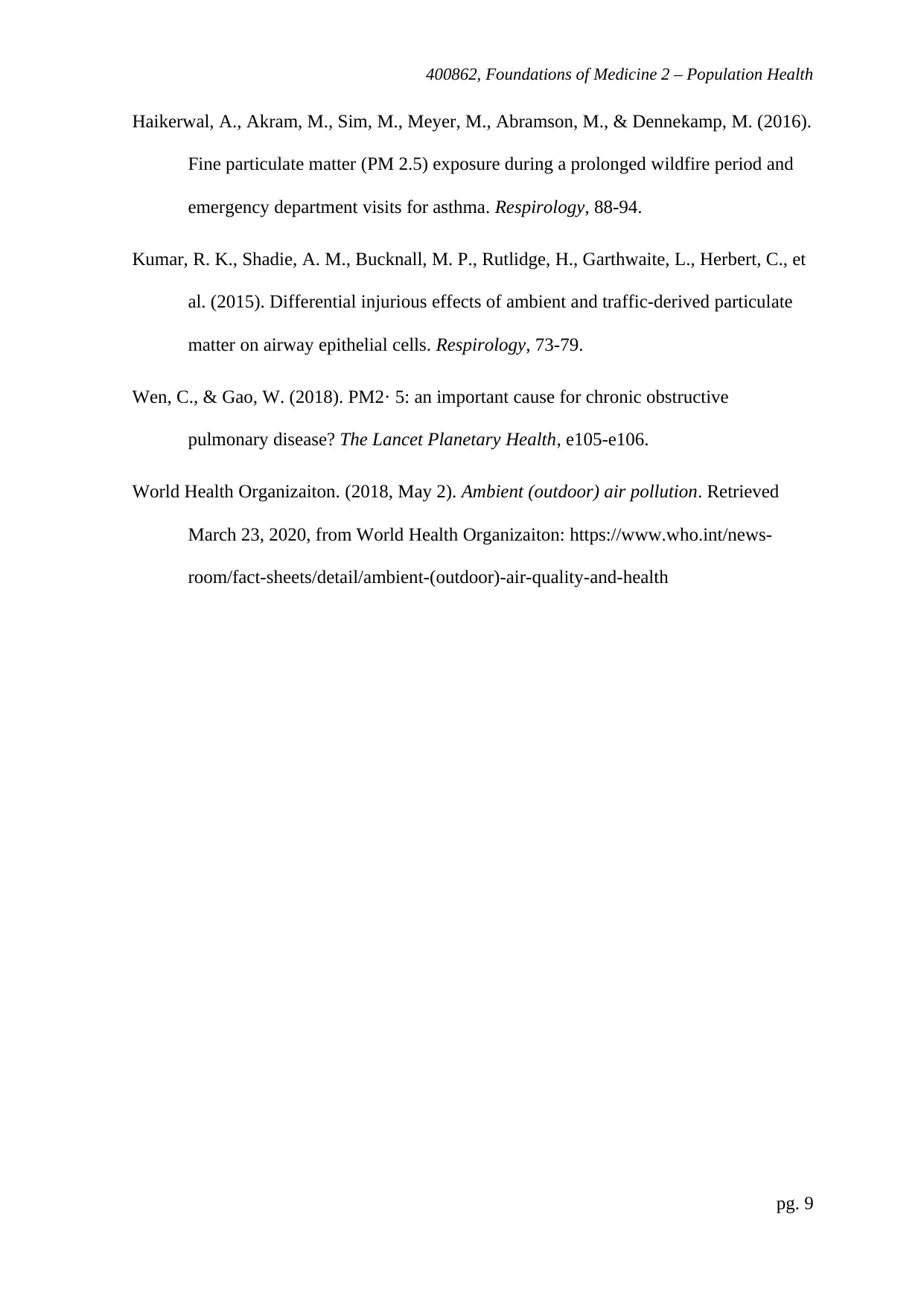
400862, Foundations of Medicine 2 – Population Health
Haikerwal, A., Akram, M., Sim, M., Meyer, M., Abramson, M., & Dennekamp, M. (2016).
Fine particulate matter (PM 2.5) exposure during a prolonged wildfire period and
emergency department visits for asthma. Respirology, 88-94.
Kumar, R. K., Shadie, A. M., Bucknall, M. P., Rutlidge, H., Garthwaite, L., Herbert, C., et
al. (2015). Differential injurious effects of ambient and traffic‐derived particulate
matter on airway epithelial cells. Respirology, 73-79.
Wen, C., & Gao, W. (2018). PM2· 5: an important cause for chronic obstructive
pulmonary disease? The Lancet Planetary Health, e105-e106.
World Health Organizaiton. (2018, May 2). Ambient (outdoor) air pollution. Retrieved
March 23, 2020, from World Health Organizaiton: https://www.who.int/news-
room/fact-sheets/detail/ambient-(outdoor)-air-quality-and-health
pg. 9
Haikerwal, A., Akram, M., Sim, M., Meyer, M., Abramson, M., & Dennekamp, M. (2016).
Fine particulate matter (PM 2.5) exposure during a prolonged wildfire period and
emergency department visits for asthma. Respirology, 88-94.
Kumar, R. K., Shadie, A. M., Bucknall, M. P., Rutlidge, H., Garthwaite, L., Herbert, C., et
al. (2015). Differential injurious effects of ambient and traffic‐derived particulate
matter on airway epithelial cells. Respirology, 73-79.
Wen, C., & Gao, W. (2018). PM2· 5: an important cause for chronic obstructive
pulmonary disease? The Lancet Planetary Health, e105-e106.
World Health Organizaiton. (2018, May 2). Ambient (outdoor) air pollution. Retrieved
March 23, 2020, from World Health Organizaiton: https://www.who.int/news-
room/fact-sheets/detail/ambient-(outdoor)-air-quality-and-health
pg. 9
1 out of 10
Related Documents
Your All-in-One AI-Powered Toolkit for Academic Success.
+13062052269
info@desklib.com
Available 24*7 on WhatsApp / Email
![[object Object]](/_next/static/media/star-bottom.7253800d.svg)
Unlock your academic potential
Copyright © 2020–2025 A2Z Services. All Rights Reserved. Developed and managed by ZUCOL.





